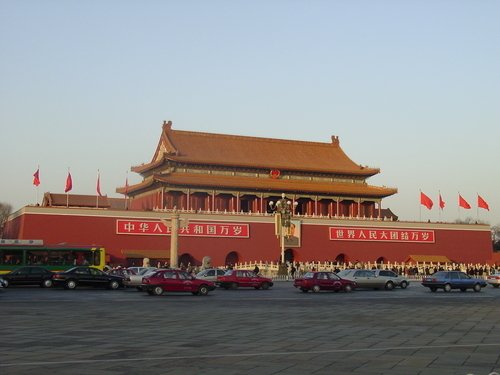The symbol of New China, this gate was built in 1417 and renovated in 1981. It was originally called the Gate of Heavenly Succession. The late Chairman Mao proclaimed the founding of the People's Republic of China on the rostrum on October 1st, 1949. The gate has five passages, which were closed and used only on ceremonial occasions in the old days. The emperor alone was entitled to pass through the central passage. Before leaving on a journey he would make a sacrifice in front of the gate.
At other times imperial edicts were sent down, in a gilded box shaped like a phoenix, to officials kneeling below. Hence the expression:" the Imperial Orders Given by the Gilded Phoenix." The edict was then taken to the Ministry of Rites where copies were made for dispatch to the whole country.
Tian'anmen Square
Tian'anmen Square occupies an area of 49 hectares (122 acres), big enough to hold half a million people. The square has witnessed the Chinese people's struggle against foreign aggression and reactionary rule at home.
In 1919, the May 4th Movement broke out in Beijing. Students and residents staged a patriotic demonstration in the square. In 1935, students in Beijing launched the
December 9th Movement against the Japanese aggression and Chiang Kai-shek's policy of non-resistance, They held a demonstration in the square.
On April 5, 1976, lots of people gathered here to commemorate Zhou Enlai and oppose the "Gang of Four".
Many tourists to Tian'anmen Square would like to have their pictures taken in front of the white marble Jinshuiqiao (Gold Water Bridges).
The bridges were named after the Gold Water River they span, Seven bridges, each supported by three arches, cross the Outer Gold Water River in front of Tian'anmen, Zhongshan Park, and the Beijing Working People's Palace of Culture. Five one-arched bridges cross the Inner Gold Water River inside the Forbidden City between Wumen (Meridian Gate) and Taihemen (Gate of Supreme Harmony).
The outer bridges, together with two graceful Huabiao (ornamental columns) and two stone lions nearby, set off Tian'anmen, making it look more imposing. The inner bridges make the spacious square look harmonious.
During the Ming and Qing (1368 - 1911) dynasties, the middle one of the seven outer bridges, which is larger than the others was called Yuluqiao (Bridge of the Imperial Way) and was used exclusively by the emperor. The two bridges on each side
were called Wanggongqiao (Royal Bridges) and were used by the royal family. The two bridges farther out were the Pinjiqiao (Ranking Bridges) and were used by civil and military officials above the third rank. Those of the fourth rank and below could use only the outer two bridges, which were called Gongshengqiao (Public Bridges).
Help: renovate vt. 修复
rostrum n. 讲台,演讲坛
gilded adj. 镀金的,装饰的
phoenix n. 凤凰
reactionary adj. 反动的
commemorate vt. 纪念
span vt. 横跨,延伸
